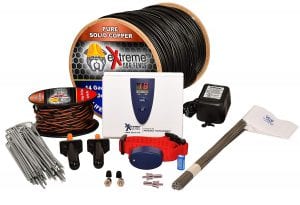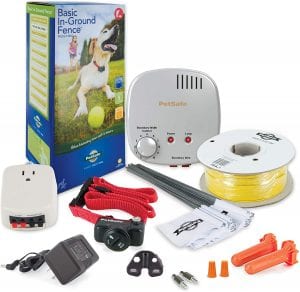The Best Invisible Fence

Our Review Process
Don't Waste Your Money is focused on helping you make the best purchasing decision. Our team of experts spends hundreds of hours analyzing, testing, and researching products so you don't have to. Learn more.
Our Picks For The Top Invisible Fences
- 1. PetSafe Replaceable Battery Circular Invisible Fence
- 2. Extreme Dog Fence In-Ground Electric Invisible Fence
- 3. WIEZ Vibrating Waterproof Invisible Fence
- 4. Aweec Water Resistant 2-In-1 Invisible Fence
- 5. BHCEY Adjustable Strength Invisible Fence For Pets
- 6. SportDOG Easy Install Pet Invisible Fence System
- 7. Free Spirit Adjustable Strap Invisible Fence
- 8. Extreme Dog Fence Waterproof Submersible Invisible Fence
- 9. Perimeter Technologies Lightweight Waterproof Invisible Fence
- 10. COVONO Dog Training Unlimited Collars Invisible Fence
- 11. Pet Control HQ Humane Customizable Invisible Fence
- 12. PetSafe Basic DIY Static Correction Invisible Fence
- 13. High Tech Pet Waterproof Automatic Invisible Fence
- 14. TTPet Beap & Shock Collar Expandable Invisible Fence
- 15. PetSafe Stay+Play Dome Correction Free Invisible Fence
This invisible fence eliminates the need to bury wire, making installation a breeze. In addition to allowing the ability to move your system to a new location if necessary, you can add pets by merely purchasing another collar. You can also set it to only issue a tone when your dog breaches the boundary, which may be a big help with training.
Easy InstallationThis wire-free system keeps your pet contained with either a special tone or the traditional static connection.
Keep your dog safe within your property lines using this invisible fence. Although this system is designed for use with one dog, there is the option to purchase a system that can accommodate as many as five dogs. It's easy to install and everything you need to train your dogs to use the system is found inside the kit.
Training Flags IncludedEven if this invisible fence collar is submerged under 10 feet of water, it will still perform perfectly.
Instead of a wire and radio frequency technology, this innovative invisible fence uses satellites and GPS technology to keep dogs within your boundaries. It works in ranges of up to 3,300 feet, which means your pup will have plenty of room to roam around. Since the system doesn't require a transmitter, you can have it set up and ready to go within ...
Large Coverage AreaWith this invisible fence, you'll be able to adjust both the level of vibration and the level of shock.
You can't go wrong with this invisible fence, as it has a long range of 6,560 feet. It's best used with dogs of a medium or large size, as the adjustable collar may not go small enough for little dogs. The technology uses a combination of GPS and vibrations or shocks to keep your canine within the set boundaries.
Budget-Friendly PickYou don't have to spend a fortune to keep your dog from running off the property, as this invisible fence has an affordable price tag.
Buying Guide
Life with a dog in today’s neighborhoods can be tough. Some don’t allow fences and even in those that do, the type of fencing allowed can be extremely expensive. Taking a dog out on a leash multiple times a day gets old quickly. Plus, dogs benefit from being able to run and play freely.
Invisible fencing is a great alternative to pricey, obstructive fencing. Today’s invisible fencing options mean you don’t even have to bury a wire if you prefer. After an initial training period, you’ll hopefully find your dog doesn’t even try to cross the barrier, keeping Fido safe while also giving him the freedom to roam.
The biggest decision you’ll face when you commit to buying an electric fence is whether to go with a wireless or traditional model. Traditional electric fences involve burying wire — a process that can be time-consuming and labor-intensive. Although wireless fences clearly have that advantage, they do have a few issues. They use a transmitter to send a signal, which means bulky items can interfere. They also may not work as well on smaller yards or in bad weather.
Weather is a consideration with all electric fences. It’s important to make sure the collar that comes along with any electric fence you buy is waterproof. Otherwise, it could short out and harm your dog. You’ll find many of the collars on the market offer that feature. Another weakness of electric fences is that they keep your dog contained, but they don’t restrict your yard from visitors. For this reason, you may want to keep an eye on your dog and have a plan in case a stray dog, critter or even a person happens to walk through your yard.
Electric fencing has been associated with sending a shock to the dog, but many of today’s units use sound as a deterrent, with the jolt being the final measure. A continuous beep will warn the dog who, when properly trained, will gradually learn to avoid that area. Some dogs never even need a physical warning.
Overall, though, many people have found electric fences provide a great level of security. Once trained, you’ll find your dog likely doesn’t even stray to the edge of the yard. Experts recommend multiple short training sessions initially with flags around the yard. You’ll walk your dog on a leash, helping him learn the boundary area. As the dog nears the boundary, the unit will beep, eventually teaching him to avoid that area.
What to Look For
- The first choice you’ll need to make is whether you want a traditional buried-wire fence or a wireless system. PetSafe Wireless Fence Pet Containment is a wireless model, which means you won’t have to install any wire. This also makes it more flexible than wired models, which will require you to dig up any existing wire or install new wire if you ever want to alter the range. Some hybrid models use a combination of a wireless receiver and wire in the ground to keep pets safe.
- Some households have more than one dog. Even if that isn’t you yet, consider that you may eventually decide Benji needs a companion. With PetSafe Wireless Fence Pet Containment, you can buy additional collars at a more affordable price, which could sway you in the direction of a wireless fence.
- Some companies sell their systems based on the number of dogs you have, with the price jumping up significantly from one to two or three dogs. The big negative to this is that if you add a dog later, you’ll have to upgrade your system rather than just adding another collar.
- This may not top your list of features, but some systems are able to offer fitness tracking. You’ll be able to see the percentage of time your dog spends resting versus active, as well as how much of that active time is spent engaging in mild and intense activity.
- Coverage area is important as well. Some systems cover 1.3 acres out of the box. You may even be able to purchase more flag receptors to increase that up to 10 acres. With other systems, you’ll choose from 500 feet to 2,500 feet, with the latter option only increasing the cost slightly. However, you can purchase additional wire to expand that unit up to 10 acres. The PetSafe Wireless Fence Pet Containment covers up to half an acre, but it’s important to note that wireless units rely on a signal. You’ll be able to adjust within 90 feet in each direction, so that can put restrictions on the area in which you can use it.
- Dog size can also restrict which unit you choose, especially if you have an extremely small dog. Some systems are limited to dogs over 10 pounds, while PetSafe Wireless Fence Pet Containment works with dogs as small as 8 pounds, with neck sizes between 6 and 28 inches.
- If you’re working with a budget, you’ll find many electric fences range in price. However, you’ll add to that price if you want to expand your coverage area or if you have more than one pet to safeguard.
- Any purchase of a new electric fence will start with a training period. Some of today’s fences use tone-based correction, with the shock kicking in only once that part of correction fails. There are systems that send a tone and vibrate the collar as the dog nears the boundary area, which will be enough to encourage some dogs to back off. The PetSafe Wireless Fence Pet Containment has a tone-only mode that you can use during training.
- As for the physical correction portion of your electric fencing, some systems use four correction levels that you set, each increasing in intensity. The PetSafe Wireless Fence Pet Containment has five correction levels.
- You probably already know that water and electricity don’t mix very well, but your dog will still have to go out when it’s raining. For that reason, there are many waterproof collars now.
- If there’s an issue with your in-ground wire, you may not realize it until it’s too late. Some systems remedy that by sending an alarm if a problem is detected with the boundary wire.
- With in-ground systems, you’ll, unfortunately, need to do some digging and burying when your wire first arrives.
- Your collars will come with batteries that have to be replaced. But these collars are known for going through batteries fairly quickly. There are systems that take a standard 9-volt battery that you can buy in any hardware store. The PetSafe Wireless Fence Pet Containment collar, on the other hand, requires a special replacement battery that you have to special order every time.
- One additional benefit of a wireless fence like PetSafe Wireless Fence Pet Containment is portability. If you move, you simply pack up all your items and go. With in-ground systems, you’ll need to dig everything up and install it at the new location.
- Another safety feature not found on all electric fences is lightning surge protection. Look for a system that has that protection built into its transmitter.
- Look for a system that also includes an operating guide with training tips to help walk you through those tough early days.
- One benefit of certain systems is that they include bark control. This will help with cutting down on barking, which can be particularly important if you live in close proximity to other homes.
More to Explore
You may have only begun hearing about electric fencing for dogs in recent years, but the technology has actually been in use for more than a century. You likely first heard about the electric fence in a movie since it was initially used to deter people from crossing certain barrier lines.
It was invented in New Zealand in 1936 by an inventor who wanted to deter his horses from getting close to his car. At first, this type of fencing was expensive and had a limited range. It became more prevalent in the 1960s, when an inventor adjusted the technology, making it not only more affordable but safer.
Invisible pet fences came along in the 1970s when a traveling salesman named Richard Peck came up with the idea for what would become known as the Invisible Fence brand. The fence provided a way to train pets to stay in their yard that was safer than traditional electric fencing.

























